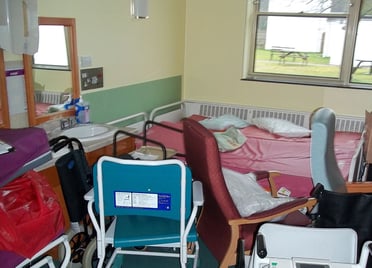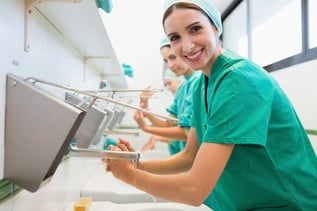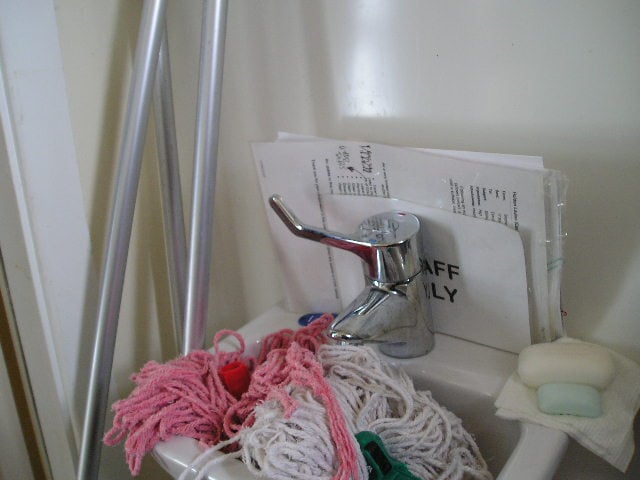The use of ‘temperature’ is the accepted and ‘traditional' method of control for ensuring waterborne bacteria such as Legionella within healthcare domestic water distribution systems (ACoP L8, HSG274 Part 2 - paragraph 2.6 and HTM04-01 Part B - paragraph 4.7). There are an increasing number of methods which can be employed to suitably disinfect these systems (chemical, physical as well as thermal) thus mitigating the risk of local or system-wide bacterial colonisation and associated infection and disease that can follow when patients come into contact with waterborne pathogens.
Strategies to control waterborne pathogens in healthcare
It’s widely accepted that the sufficient turnover of water (including a Legionella flushing regime of infrequently used outlets) and adherence to the prescribed hot and cold water temperatures (detailed in HSG274 Part 2 – paragraph 2.6 and Appendix 2:2 as well as HTM 04-01 Part B, paragraphs; 4.7 & 5.11) dominate the water treatment strategies which can be employed to control waterborne pathogens such as Legionella and Pseudomonas-aeruginosa within healthcare estates.
Firstly; the movement and velocity, of water whilst under sufficient pressure will create a ‘shearing’ force within the system which seldom provides the ubiquitous planktonic (free-floating) bacterial cells with the opportunity to settle and adhere to the inner surface of pipework (often resulting in the early stages of biofilm formation, known as conditioning). As such, these planktonic cells and system-wide particulates are moved through the water system and then largely and harmlessly flushed to drain.
Secondly; waterborne pathogens such as Legionella typically grow or multiply between temperatures of 20-45°C. Therefore, provided that the cold water is ‘cold’ (<20°C) and the hot water is ‘hot’ (stored at >/=60°C and returned at >/=50°C), both temperature control and the sufficient turnover of water remain very effective methods for controlling the bacterial load and any waterborne pathogens in health estates.
Mitigate the risk of colonisation
 Eliminating the stagnation of water is also imperative for mitigating the risk of biofilm formation - both within the system and within the asset (shower or tap/outlet).
Eliminating the stagnation of water is also imperative for mitigating the risk of biofilm formation - both within the system and within the asset (shower or tap/outlet).
Therefore, as well as ensuring an outlet is in regular use and flushing is carried out – where appropriate, it’s also prudent to ensure that these outlets are suitably cleaned and free from scale - which may also harbour harmful aquatic bacteria.
The adequate cleaning of assets will help to mitigate the risk of colonisation from a biofilm which may harbour bacteria such as Pseudomonas aeruginosa, which is an opportunistic microorganism (awaiting a breach in the host defences) that frequently colonises infrequently used or inadequately maintained outlets.
A biofilm is a complex layer of microorganisms that have attached to a surface and grown. A biofilm provides a niche environment for many microorganisms to interact with other organisms all within a protected state. As such, biofilms provide a safe haven and favourable conditions in which organisms i.e. bacteria such as Legionella can grow.
Legionella bacteria will rarely survive (in planktonic form) outside of biofilm or a protozoan host, therefore in ensuring that outlets are free from scale (also considered a biofilm) as far as reasonable and practicable, will help to mitigate the risk of individuals contracting a waterborne infection. In this sense, control the ‘home’ in which aquatic bacteria propagate and proliferate, to control the risk.
.jpg?width=294&name=Tap%20(1).jpg) Scale formation will vary considerably based on the geographic location of the estate, so for that reason, consideration must be given to the ‘natural chemistry’ of the water in the system being managed and how that may impact cleaning frequency. ‘Hard water’ areas (those with an abundance of calcium carbonate) will undoubtedly require greater vigilance (with regards to scale formation) than ‘soft water’ areas due to hard water’s propensity to produce more scale. For this reason, ‘periodic’ cleaning is advised in HTM 04-01, whereby the frequency of cleaning is ‘site/system specific’.
Scale formation will vary considerably based on the geographic location of the estate, so for that reason, consideration must be given to the ‘natural chemistry’ of the water in the system being managed and how that may impact cleaning frequency. ‘Hard water’ areas (those with an abundance of calcium carbonate) will undoubtedly require greater vigilance (with regards to scale formation) than ‘soft water’ areas due to hard water’s propensity to produce more scale. For this reason, ‘periodic’ cleaning is advised in HTM 04-01, whereby the frequency of cleaning is ‘site/system specific’.
Mitigate the risk of cross-contamination
The importance of adequately cleaning outlets whilst ensuring that assets are not misused (WHB are to be used for hand washing only) is a key consideration in HTM 04-01, whereby guidance in this regard is given specifically to mitigate the risk of augmented care patients acquiring Pseudomonas aeruginosa infections.
 Moreover, the focus of HTM-0401 guidance is not only to ensure that assets are suitably cleaned, but to also mitigate the risk of cross-contamination of assets (WHB & taps) with waterborne bacteria such as Pseudomonas aeruginosa. With this in mind, it’s noteworthy that whilst it’s accepted that tap and shower outlets may be a reservoir for contamination for bacteria such as Pseudomonas aeruginosa, one must also consider that Pseudomonas bacteria are ubiquitous. Therefore, just because an outlet becomes colonised with these bacteria the associated water system doesn’t always represent the underlying cause of the problem, especially when non-conformances have been observed from either a cleaning or use (misuse) perspective.
Moreover, the focus of HTM-0401 guidance is not only to ensure that assets are suitably cleaned, but to also mitigate the risk of cross-contamination of assets (WHB & taps) with waterborne bacteria such as Pseudomonas aeruginosa. With this in mind, it’s noteworthy that whilst it’s accepted that tap and shower outlets may be a reservoir for contamination for bacteria such as Pseudomonas aeruginosa, one must also consider that Pseudomonas bacteria are ubiquitous. Therefore, just because an outlet becomes colonised with these bacteria the associated water system doesn’t always represent the underlying cause of the problem, especially when non-conformances have been observed from either a cleaning or use (misuse) perspective.
In summary
The principles behind ensuring that water is microbiologically safe are quite straightforward, but ongoing compliance to ensure these principles are adhered to takes time, consideration and buy-in from several key stakeholders such as infection control teams, medical microbiology, estates, health & safety, projects & design and most certainly facilities.
To this end, the formation of Water Safety Groups (WSG) which are multidisciplinary groups with responsibility for ensuring the safety and quality of water, are an important tool in managing water.
In addition, these groups also welcome professional support from Authorising Engineers (Water) – to provide further advice and support with shaping Water Safety Plans and policies - to help ensure that all appropriate operational and managerial water safety concerns have been considered and that the organisation understands its health and safety obligations (in this regard) and how to comply with them.
Learn all about what a legionella risk assessment is >
Feel free to reach out if you have any questions about the issues mentioned above or if you would like to consult with one of our experts on water hygiene.
Editors Note: The information provided in this blog is correct at the date of original publication – September 2022. [Revised February 2024]
© Water Hygiene Centre 2024









